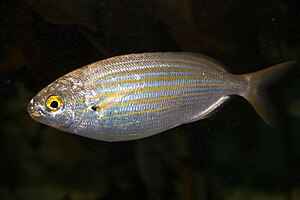
Several species of fish are claimed to produce hallucinogenic effects when consumed, a condition known as ichthyoallyeinotoxism. For example, Sarpa salpa, a species of sea bream referred to as the "dream-fish", is commonly claimed to be hallucinogenic.[1][2] These widely distributed coastal fish are normally found in the Mediterranean and around the Iberian Peninsula, west to the Azores and along the west and south coasts of Africa.[3] Occasionally they are found in British or more northerly waters.[4] They may induce hallucinogenic effects similar to LSD (lysergic acid diethylamide) if eaten.[5] However, based on the reports of exposure they are more likely to resemble hallucinogenic effects of deliriants than the effects of serotonergic psychedelics such as LSD. In 2006, two men who apparently ate the fish experienced hallucinations lasting for several days (an effect common with some naturally occurring deliriants).[6][7] The likelihood of hallucinations depends on the season.[8][9] Sarpa salpa is known as "the fish that makes dreams" in Arabic.[6]
Other species claimed to be capable of producing hallucinations include several species of sea chub from the genus Kyphosus.[6] It is unclear whether the toxins are produced by the fish themselves or by marine algae in their diet. Other hallucinogenic fish are Siganus spinus,[10] called "the fish that inebriates" in Reunion Island, and Mulloidichthys flavolineatus (formerly Mulloidichthys samoensis),[11] called "the chief of ghosts" in Hawaii.[12]
- ^ Orsolini, L.; Ciccarese, M.; Papanti, D.; De Berardis, D.; Guirguis, A.; Corkery, J. M.; Schifano, F. (2018). "Psychedelic fauna for psychonaut hunters: a mini-review". Frontiers in Psychiatry. 9: 153. doi:10.3389/fpsyt.2018.00153. PMC 5992390. PMID 29910745.
- ^ Jawad, Laith A. (2017). "Hallucinogenic fish". Dangerous Fishes of the Eastern and Southern Arabian Peninsula. Springer International. pp. 177–185. ISBN 978-3-319-57926-9.
- ^ Cite error: The named reference
FBsalpawas invoked but never defined (see the help page). - ^ "Fish that triggers hallucinations found off British coast". The Telegraph. 13 May 2009.
- ^ "'Hallucination' fish netted in Channel". The Guardian. 13 May 2009.
- ^ a b c de Haro, L.; Pommier, P. (2006). "Hallucinatory fish poisoning (ichthyoallyeinotoxism): two case reports from the Western Mediterranean and literature review". Clinical Toxicology. 44 (2): 185–8. doi:10.1080/15563650500514590. PMID 16615678. S2CID 41191477.
- ^ Clarke, Matt (19 April 2006). "Men hallucinate after eating fish". Practical Fishkeeping. Archived from the original on 5 June 2011. Retrieved 31 March 2010.
- ^ Cite error: The named reference
Bellassoued2012was invoked but never defined (see the help page). - ^ de Haro L, Jouglard DE, Thomas MJ, David JM (1994). "Intoxications de type ciguatera after eating the Sparidae in Mediterranean". In Boudoresque, CF, Meinsez A, Gravez V (eds.). First International Workshop on Caulerpa taxifolia. France: GIS Posidonie Publ. pp. 271–274. ISBN 978-2-905540-19-5.
- ^ Cite error: The named reference
FBspinuswas invoked but never defined (see the help page). - ^ Cite error: The named reference
FBflavolineatuswas invoked but never defined (see the help page). - ^ Thomas, Craig; Scott, Susan (1 June 1997). All Stings Considered: First Aid and Medical Treatment of Hawai'i's Marine Injuries. Hawaii: University of Hawai'i Press. p. 120. ISBN 978-0-8248-1900-2.